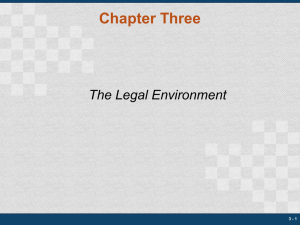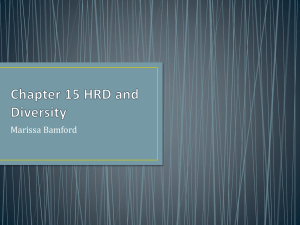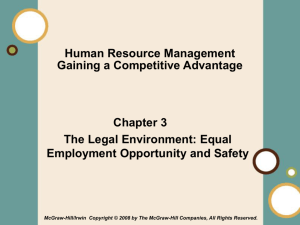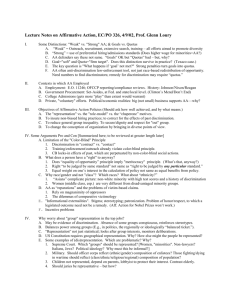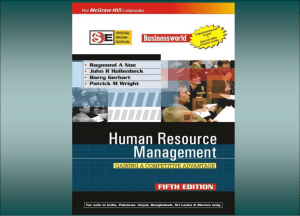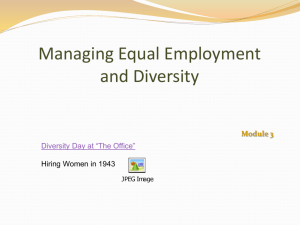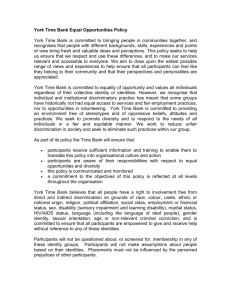Lecture 3 - Spears School of Business
advertisement
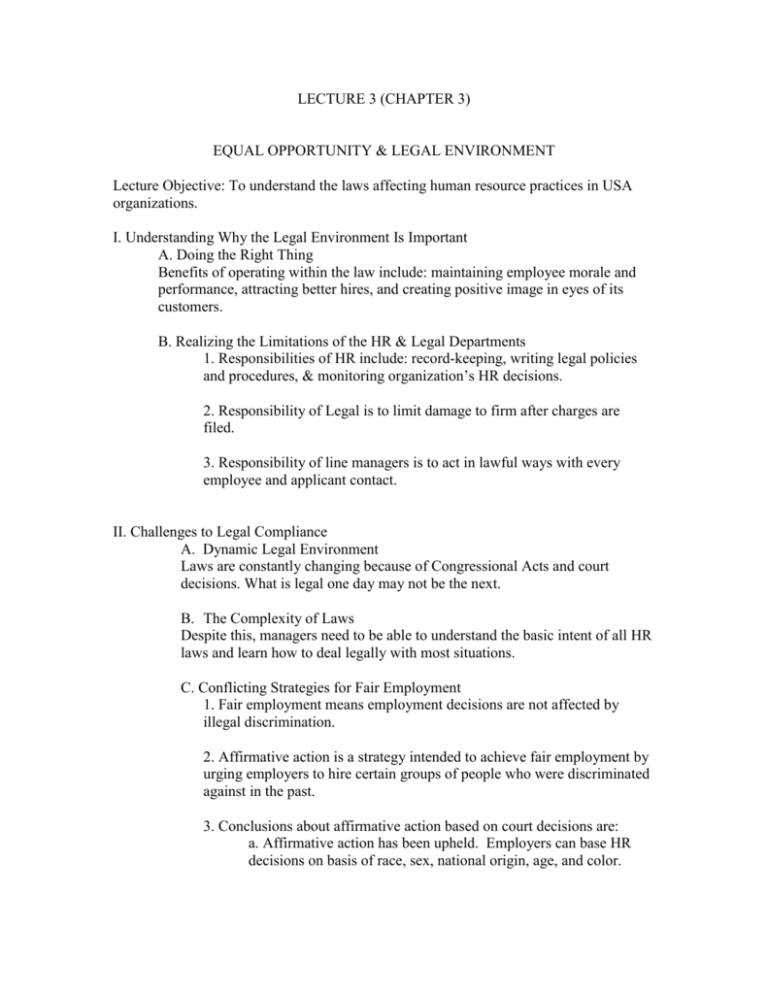
LECTURE 3 (CHAPTER 3) EQUAL OPPORTUNITY & LEGAL ENVIRONMENT Lecture Objective: To understand the laws affecting human resource practices in USA organizations. I. Understanding Why the Legal Environment Is Important A. Doing the Right Thing Benefits of operating within the law include: maintaining employee morale and performance, attracting better hires, and creating positive image in eyes of its customers. B. Realizing the Limitations of the HR & Legal Departments 1. Responsibilities of HR include: record-keeping, writing legal policies and procedures, & monitoring organization’s HR decisions. 2. Responsibility of Legal is to limit damage to firm after charges are filed. 3. Responsibility of line managers is to act in lawful ways with every employee and applicant contact. II. Challenges to Legal Compliance A. Dynamic Legal Environment Laws are constantly changing because of Congressional Acts and court decisions. What is legal one day may not be the next. B. The Complexity of Laws Despite this, managers need to be able to understand the basic intent of all HR laws and learn how to deal legally with most situations. C. Conflicting Strategies for Fair Employment 1. Fair employment means employment decisions are not affected by illegal discrimination. 2. Affirmative action is a strategy intended to achieve fair employment by urging employers to hire certain groups of people who were discriminated against in the past. 3. Conclusions about affirmative action based on court decisions are: a. Affirmative action has been upheld. Employers can base HR decisions on basis of race, sex, national origin, age, and color. b. Employment decisions cannot be made solely on the basis of race, sex, age, national origin etc. All selected should be essentially equally qualified. c. In cases of layoff, rules applying must be blind. d. Courts may order affirmative action with specific quotas when an organization has a history of blatant discrimination. D. Unintended Consequences For example, ADA has become a national worker’s compensation law as current employees have filed most of the complaints under this law and opportunities for the disabled have not improved. III. Equal Employment Opportunity Laws A. The Equal Pay Act of 1963 states that men and women in the same job in the same organization must make the same pay. It does not mean that merit pay or seniority pay is not allowed. B. Title VII of the Civil Rights Act of 1964 provides that employment decisions cannot be based on race, color, religion, sex, or national origin. 1. General Provisions: a. Prohibits discrimination in compensation, terms, conditions, or privileges of employment. b. Covers protected classes: African Americans, Asian Americans, Latinos, Native Americans, and women. 2. Discrimination is making distinctions among people. a. Disparate treatment occurs when an employer treats an individual differently because of his/her protected status. b. Adverse impact occurs when the same standard is applied to all applicants or employees but that standard affects a protected class more adversely than the non-protected class. (See Figure 3.3 for differences between disparate treatment and disparate impact.) 3. Defense of Discrimination Charges Prima facie means on its face. For a disparate treatment case, complainant needs to show that the organization did not hire him/her, that he/she appeared to be qualified, and the organization continued to try to fill the position after rejecting her/him. In an disparate impact case, complainant needs to show that a restricted policy is in effect, in that a disproportionate number of protected-class individuals were affected by the use of the policy. a. Four-fifths rule: comparing the selection rates of protected classes to white males. When the rate of a protected class is less than 4/5ths of rate of white males, disparate impact has occurred. b. Job relatedness means the employer claims the decision was made for job-related reasons. c. BFOQ refers to a characteristic that must be present in all employees for a particular job. (Actor role in a movie) d. Seniority rules can influence decisions as long as they have been consistently applied. e. Business necessity means that a policy can be justified if it can be shown it is necessary for the safe and efficient operation of the organization. (Say drug tests discriminate against Texas female truck drivers but protects public against their driving habits.) 4. Title VII & Pregnancy 1978 amendment to Title VII protected pregnant women against discrimination. They must be treated just like organization treats other employees with any medical condition. 5. Sexual Harassment a. Quid pro quo: sexual harassment that occurs when sexual activity is required in return for any job-related benefit. b. Hostile work environment: sexual harassment that occurs when the behavior of anyone in the work environment is sexual in nature and perceived by an employee as offensive and undesirable. c. Two employer defensive steps: a) prove that it exercised reasonable care to prevent and correct sexual harassment problems in a timely manner. b) prove that the complainant failed to use the internal procedures for reporting sexual harassment and that those procedures are fair. C. The Civil Rights Act of 1991 Three important effects are: a) reestablished the Griggs vs Duke Power standard for complainant’s burden of proof, b) forbids quotas but not preferences, c) awards complainants punitive and compensatory damages. D. Executive Order 11246 This presidential order exercised by Johnson required the federal government’s departments and agencies to have affirmative action plans. It also meant that any private firm having a contract with the federal government had to file AA plans as well. An affirmative action plan promotes the employment of protected-class citizens. E. Age Discrimination in Employment Act of 1967 Prohibits discrimination against people who are 40 or older. Jokes as well as HR decisions. Amended in 1990 by Older Workers Protection Act mandates benefit uniformity. E. Americans with Disabilities Act of 1990 Forbids employment discrimination against people with disabilities who are able to perform the essential functions of the job with or without reasonable accommodation. Individuals with disabilities are people who have a physical or mental impairment that substantially affects one or more major life activities such as walking, reading, speaking, lifting etc. 1. Essential functions of a job what must be done in order to do the job effectively which cannot be gotten around. 2. Reasonable accommodation refers to an action taken to allow a person with a disability to perform a job such as wheelchair accessibility, reassigning marginal duties, modifying training materials etc. IV. EEO Enforcement & Compliance A. EEOC, the agency most involved in enforcement of our employment discrimination laws. Three major functions 1. Processing discrimination complaints: it investigates complaints, attempts to resolve the complaint through conciliation, and then may litigate the complaint. 2. Issuing written regulations that interpret the laws and make them more concrete. 3. Gathering and disseminating information: employers are required to file an annual EEO-1 and post EEO posters in the workplace. B. OFCCP Differs from EEOC in that it monitors and enforces laws and executive orders only for federal government and private sector organizations that have government contracts. It actively monitors compliance with laws as affirmative action plans are required to be filed by federal government agencies and all firms contracting with any agency. It can punish these contracting firms by canceling contracts or levying fines. C. Affirmative Action Plans Three steps include: conducting a utilization analysis, establishing goals and timetables, and determining action options. 1. Utilization analysis describes the organization’s current workforce relative to the pool of qualified workers in the labor force. a. Part one: determine the demographic composition of the current workforce by dividing all the organization’s jobs into classifications and calculating the percentage of each protected class in each classification. b. Part two: determine the percentage of those protected classes in the available labor market and compare current workforce demographics to available labor market demographics. 2. Goals & timetables are for correcting any underutilization of protected classes. 3. Action plans refer to taking steps to increase employment of protected class persons where underutilization exists. The heart of affirmative action plans is increasing employment rates of protected class persons. Four guidelines: a. recruit protected class persons b. redesign jobs so protected class members can more easily qualify c. provide specialized training for protected class members. d. remove any unnecessary barriers to employment like van service from a point easily accessible by public transport. 4. Reverse discrimination refers to discrimination against white males who are referred to as non-protected class members. V. Immigration Laws A. Immigration & Control Act of 1986 Mandates that employers hire only people who can document that they are legally permitted to work in the USA (I-9s) B. Immigration Act of 1990 Designed to make it easier for skilled immigrants to enter USA. C. Drug-Free Workplace Act of 1988 It requires that government contractors try to make their workplaces free from illegal drug use and has thus led to drug testing. Almost all major corporations do drug testing of some kind. D. Uniformed Services Employment and Reemployment Rights Act of 1994 This law protects employee seniority and benefits while and after they serve in our armed forces. It also protects them from being discriminated against in hiring, promotion and layoff decisions. VI. Appendix: Pages 117. Review for first mid-term as well as final exam.
